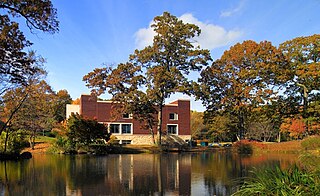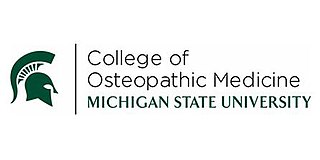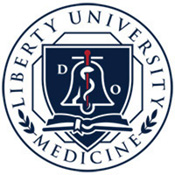Related Research Articles

Osteopathy is a pseudoscientific system of alternative medicine that emphasizes physical manipulation of the body's muscle tissue and bones. In most countries, practitioners of osteopathy are not medically trained and are referred to as osteopaths.
Osteopathic medicine is a branch of the medical profession in the United States that promotes the practice of science-based medicine, often referred to in this context as allopathic medicine, with a set of philosophy and principles set by its earlier form, osteopathy. Osteopathic physicians (DOs) are graduates of American osteopathic medical colleges and are licensed to practice the full scope of medicine and surgery in all 50 US states; they have historically applied for medical licensure in 87 countries outside of the United States, 85 of which provided them with the full scope of medical and surgical practice. The field is distinct from osteopathic practices offered in nations outside of the U.S., whose practitioners are generally not considered part of core medical staff nor of medicine itself, but rather are alternative medicine practitioners. The other major branch of medicine in the United States is referred to by practitioners of osteopathic medicine as allopathic medicine.

Fibromyalgia is a medical condition defined by the presence of chronic widespread pain, fatigue, waking unrefreshed, cognitive symptoms, lower abdominal pain or cramps, and depression. Other symptoms include insomnia and a general hypersensitivity.

Andrew Taylor Still was the founder of osteopathic medicine. He was also a physician and surgeon, author, inventor and Kansas territorial and state legislator. He was one of the founders of Baker University, the oldest four-year college in the state of Kansas, and was the founder of the American School of Osteopathy, the world's first osteopathic medical school, in Kirksville, Missouri.

Oklahoma State University Center for Health Sciences (OSU-CHS) is a public medical school in Tulsa, Oklahoma. It also has a branch campus in Tahlequah, Oklahoma. Founded in 1972, OSU-CHS is part of the Oklahoma State University System. OSU-CHS offers a Doctor of Osteopathic Medicine (D.O.) and over fifteen other different graduate degrees.

The American Osteopathic Association (AOA) is the representative member organization for the more than 176,000 osteopathic medical doctors (D.O.s) and osteopathic medical students in the United States. The AOA is headquartered in Chicago, Illinois, and is involved in post-graduate training for osteopathic physicians. Beginning in 2015, it began accrediting post-graduate education as a committee within the Accreditation Council for Graduate Medical Education, creating a unified accreditation system for all DOs and MDs in the United States. The organization promotes public health, encourages academic scientific research, serves as the primary certifying body for D.O.s overseeing 18 certifying boards, and is the accrediting agency for osteopathic medical schools through its Commission on Osteopathic College Accreditation. As of October 2015, the AOA no longer owns the Healthcare Facilities Accreditation Program (HFAP), which accredited hospitals and other health care facilities.
The Accreditation Council for Graduate Medical Education (ACGME) is the body responsible for accrediting all graduate medical training programs for physicians in the United States. It is a non-profit private council that evaluates and accredits medical residency and internship programs.
The American Association of Colleges of Osteopathic Medicine (AACOM) is a non-profit organization that supports the 41 accredited colleges of osteopathic medicine (COMs) in the United States. These colleges are accredited to deliver instruction at 65 teaching locations in 35 states. In the current academic year, these colleges are educating more than 35,000 future physicians—25 percent of all U.S. medical students. Seven of the colleges are public and 34 are private institutions.

Nova Southeastern University Dr. Kiran C. Patel College of Osteopathic Medicine (NSU-KPCOM) is a private medical school in Davie, Florida. It is an academic division of Nova Southeastern University. The college was founded in 1981 as the only osteopathic medical school located in the Southeastern United States at the time. It confers the Doctor of Osteopathic Medicine degree and is accredited by the American Osteopathic Association's Commission on Osteopathic College Accreditation.

The Lake Erie College of Osteopathic Medicine (LECOM) is a private medical school and academic health center in Erie, Pennsylvania. LECOM has a Branch Campus in Bradenton, Florida and additional locations in Greensburg, Pennsylvania, and Elmira, New York. Founded in 1992, LECOM confers medical (D.O.), dental (DMD), podiatry (DPM), pharmacy (PharmD) degrees, as well as masters and doctoral degrees in the health sciences.
Medical school in the United States is a graduate program with the purpose of educating physicians in the undifferentiated field of medicine. Such schools provide a major part of the medical education in the United States. Most medical schools in the US confer upon graduates a Doctor of Medicine (MD) degree, while some confer a Doctor of Osteopathic Medicine (DO) degree. Most schools follow a similar pattern of education, with two years of classroom and laboratory based education, followed by two years of clinical rotations in a teaching hospital where students see patients in a variety of specialties. After completion, graduates must complete a residency before becoming licensed to practice medicine.
Most physicians in the United States hold either the Doctor of Medicine degree (MD) or the Doctor of Osteopathic Medicine degree (DO). Institutions awarding the MD are accredited by the Liaison Committee on Medical Education (LCME). Institutions awarding the DO are accredited by the Commission on Osteopathic College Accreditation (COCA). The World Directory of Medical Schools lists both LCME accredited MD programs and COCA accredited DO programs as US medical schools. Foreign-trained osteopaths do not hold DO degrees and are not recognized as physicians in the United States or in other jurisdictions.

The New York Institute of Technology College of Osteopathic Medicine (NYIT-COM) is a private medical school located primarily in Old Westbury, New York. It also has a degree-granting campus in Jonesboro, Arkansas. Founded in 1977, NYIT-COM is an academic division of the New York Institute of Technology. Formerly the New York College of Osteopathic Medicine, it is one of the largest medical schools in the United States.
Doctor of Osteopathic Medicine is a medical degree conferred by the 38 osteopathic medical schools in the United States. DO and Doctor of Medicine (MD) degrees are equivalent: a DO graduate may become licensed as a physician or surgeon and thus have full medical and surgical practicing rights in all 50 US states. As of 2021, there were 168,701 osteopathic physicians and medical students in DO programs across the United States. Osteopathic medicine emerged historically from osteopathy, but has become a distinct profession.

The Council of Osteopathic Student Government Presidents (COSGP) was established in 1972 as an official council of the American Association of Colleges of Osteopathic Medicine (AACOM) to serve as the official national representative voting voice of osteopathic medical students. There are currently 41 accredited colleges of osteopathic medicine that offer the Doctor of Osteopathic Medicine (DO) degree, with 65 locations in 35 states nationwide. The council includes a student representatives from each of these schools. COSGP serves as a national voting body within AACOM and the American Osteopathic Association (AOA) and represents the collective voice of osteopathic medical students.

The Michigan State University College of Osteopathic Medicine (MSUCOM) is one of the two public medical schools of Michigan State University, a public land-grant research university in East Lansing, Michigan. The college grants the Doctor of Osteopathic Medicine (D.O.) degree, as well as a DO-PhD combined degree for students interested in training as physician-scientists. MSUCOM operates two satellite campuses in Clinton Township and Detroit. The college is accredited by the American Osteopathic Association's Commission on Osteopathic College Accreditation (COCA) and by the Higher Learning Commission.

The College of Osteopathic Medicine of the Pacific (COMP) is a private, non-profit medical school for osteopathic medicine located in downtown Pomona, in the U.S. state of California. The college opened in 1977 as the only osteopathic medical school west of the Rocky Mountains. COMP was the founding program of Western University of Health Sciences (WesternU), which now has 8 colleges in addition to COMP, each offering professional degrees in various fields of healthcare. COMP has a single 4-year program, conferring the Doctor of Osteopathic Medicine (D.O.) degree. Graduates are eligible to practice medicine in all 50 states and more than 85 countries.

The Marian University College of Osteopathic Medicine is the medical school of Marian University in Indianapolis, Indiana. It was the first osteopathic medical school to open at a Roman Catholic university.

Liberty University College of Osteopathic Medicine (LUCOM) is a private graduate medical school located in Lynchburg, Virginia. It is one of the seventeen colleges and schools located in Liberty University. LUCOM was the second osteopathic medical school to open in the U.S. state of Virginia after the Edward Via College of Osteopathic Medicine. In 2018, the inaugural class of 126 medical students graduated.
The Canadian Osteopathic Medical Student Association (COMSA) is a student body that works to promote awareness of Osteopathic Medicine in Canada both among the general population and the future physicians of Canada. They are affiliated with the Canadian Osteopathic Association.
References
- ↑ "AACOM Names Tyler Cymet, DO, Associate Vice President for Medical Education". Aacom.org. Retrieved June 20, 2012.
- ↑ Brecher, LS; Cymet, TC (2001). "A practical approach to fibromyalgia". Journal of the American Osteopathic Association. 101 (4): S12-17. PMID 11392205.
- 1 2 "Cymet TC[Author] - PubMed - NCBI". U.S. National Library of Medicine. Retrieved August 24, 2012.
- ↑ "Tyler C. Cymet, DO". Osteopathic.org. Retrieved June 20, 2012.
- ↑ Protopapas, MG; Cymet, TC (2002). "Joint cracking and popping: understanding noises that accompany articular release". Journal of the American Osteopathic Association. 102 (5): 283–287. PMID 12033758.
- ↑ Cymet, T. C. (1992). "'Ad Diction Ary' of drug users' terms". The Journal of the American Osteopathic Association. 92 (4): 433–440, 443–440, 447–440 passim. doi: 10.1515/jom-1992-920410 . PMID 1601687. S2CID 245118260.
- ↑ "Johns Hopkins University (JHU) - SciVal Experts v3.6". Experts.scival.com. Archived from the original on January 4, 2013. Retrieved June 20, 2012.
- ↑ Erondu, U. A.; Cymet, T. C. (Winter 2006). "Chromosome 21 abnormalities a review and report of a case of erondu-cymet syndrome". Comprehensive Therapy. 32 (4): 254–260. doi:10.1007/BF02698072. PMID 17898432. S2CID 37968241.
- ↑ "Maryland Association of Osteopathic Physicians". Maops.com. Archived from the original on March 10, 2009. Retrieved June 20, 2012.
- ↑ "Maryland hospital staffs expect to spend months in Katrina relief efforts - Baltimore Business Journal". Baltimore Business Journal . Retrieved June 20, 2012.
- ↑ Joshi, SG; Cymet, HB; Kerkvliet, G; Cymet, T (May 24, 2012). "Anthrax in America 2001-2003". J Natl Med Assoc. 96 (3): 344–50. PMC 2594885 . PMID 15040516.
- ↑ Shane, Scott (June 7, 2005). "After a Shower of Anthrax, An Illness and a Mystery - NYTimes.com". The New York Times . Retrieved June 20, 2012.
- ↑ Ralph R. Frerichs. "Testing may not detect anthrax". Ph.ucla.edu. Retrieved June 20, 2012.
- ↑ "Worldandnation: Was anthrax to blame for mail deaths?". Tampa Bay Times. July 7, 2002. Retrieved June 20, 2012.
- ↑ "2011-2012 Board of Trustees". DOCARE International. Retrieved August 24, 2012.
- ↑ "Electing Pro-physician Candidates to Congress: Tyler Cymet". American Osteopathic Information Association - Osteopathic Political Action Committee. Retrieved July 5, 2012.